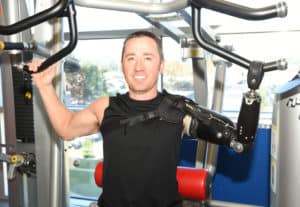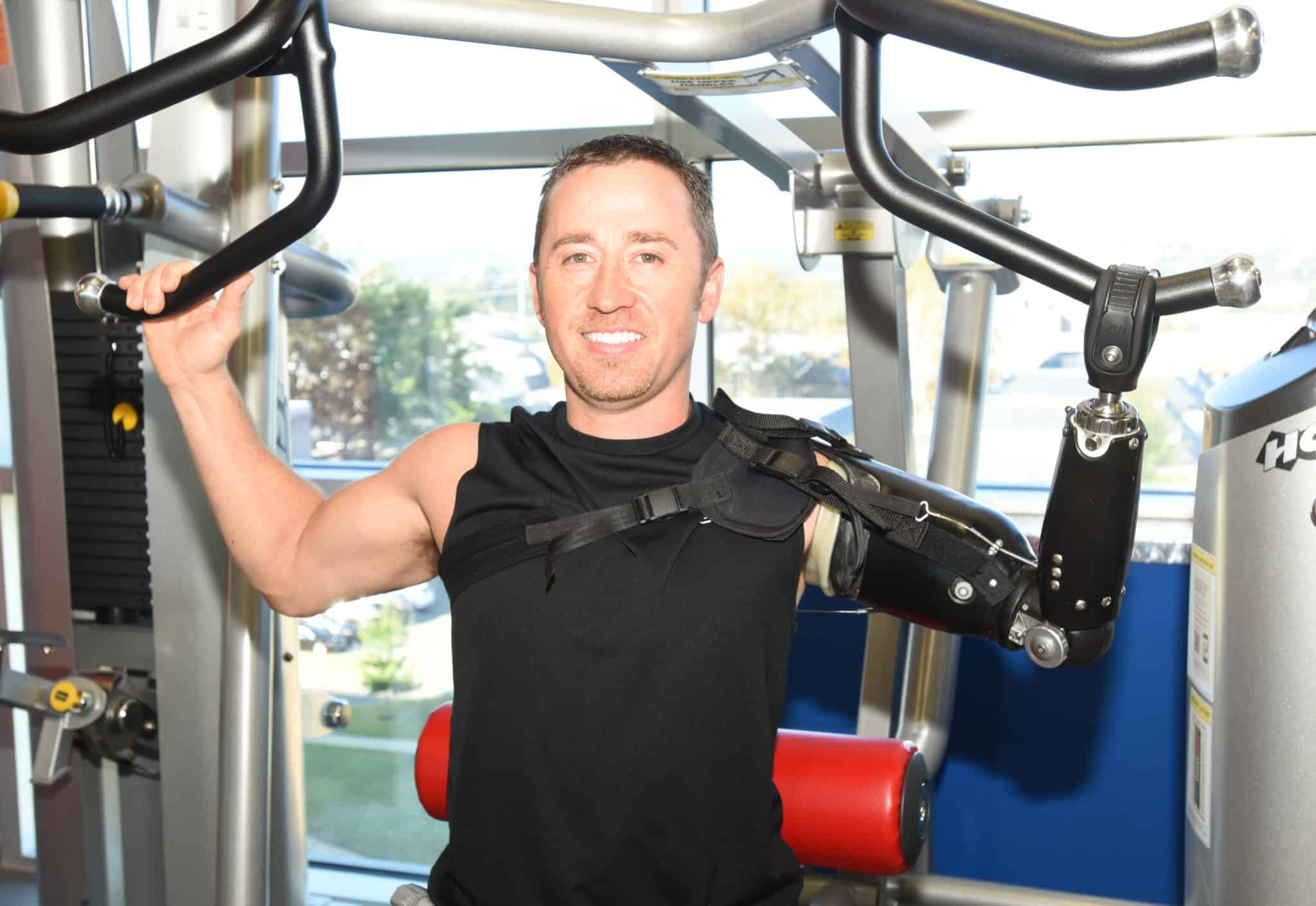January 9, 2018
First Arkansan Receives Surgery to Prepare for Robotic Arm
Jacob Mauterstock can run a half-marathon in an hour-and-a-half. He’s in the gym every day. He demonstrates yoga poses at the drop of a hat.
“It’s a lifestyle thing,” said Mauterstock, 41, of Conway.
That approach to life remains steadfast, even though Mauterstock lost his left arm in December 2016. Despite this setback and thanks to in large part to his can-do attitude, Mauterstock was the first person in Arkansas to undergo a surgery that will allow him to use a robotic arm controlled by his thoughts.
UAMS is one of the few hospitals in the nation where the surgery is

Orthopaedic surgeons Mark Tait, M.D., (left) and John Bracey, M.D., have advanced training in upper extremity surgeries.
being performed. Mauterstock’s surgeons – John Bracey, M.D., and Mark Tait, M.D. – have advanced training in upper extremity surgeries and the latest procedures.
“We were lucky that this surgery was part of our fellowship training,” Bracey said. “When we learned how to do it, we did so knowing that this was something that we wanted to bring back to Arkansas. Even though we did Jacob’s surgery soon after the accident, that isn’t necessary. For other upper body amputees, we can do this surgery up to 10 years after the amputation.”
Mauterstock was using an auger as part of a home improvement project with his fiancé when the sleeve of his shirt got caught. His arm was badly damaged, and he was rushed to UAMS, where Bracey and Tait performed an emergency amputation of his arm above the elbow.
Despite the extent of the injury, it is the philosophy of Bracey and Tait’s department – the Department of Orthopaedic Surgery in the UAMS College of Medicine – to help their patients live their best lives, whatever that looks like: knee replacements for the weekend warrior who wants to keep moving, hip replacements for the grandmother who wants to keep bending over to interact with grandkids, or whatever is necessary for active people like Mauterstock who don’t want an accident to define them.
So when they talked to Mauterstock after surgery, they told him about the procedure, called a targeted muscle reinnervation, which would prepare him for the robotic arm, called a myoelectric prosthetic. They moved some of Mauterstock’s nerves to remaining muscles on his arm. When the robotic arm is fitted in place, it will connect with those muscles and nerves to pick up electrical signals from his brain about movement.

Jacob Mauterstock leads an active lifestyle despite losing his left arm in 2016. He has undergone a surgery at UAMS that will allow him to be fitted for a robotic arm controlled by his thoughts.
The technology has been in use among military amputees for about 10 years and only recently has started becoming available for civilians.
“It’s amazing,” Bracey said. “The robotic technology has really advanced quite a bit in the past 10 years. They can create robots that can do almost anything, from the fine motor details of a robotic hand to things that are very sturdy like elbow function, lifting heavy weights.”
Eleven months later, Mauterstock is taking all the necessary steps to be prepared to receive his robotic arm, which will likely occur in 2018. He has been fitted with a temporary prototype of the robotic arm, and he is helping “train” the software that will allow his nerves and his future robotic arm to communicate.
While hooked up to electrodes that track his electrical impulses, Mauterstock is instructed to think things like “move your thumb” and “rotate your wrist.” The computer is keeping track of what signals are firing when Mauterstock thinks about these movements, and his robotic arm will be programmed to recognize his specific thought patterns and respond to them.
The prototype he has now is heavier than the robotic arm, which will be made of carbon. And it is powered by his body movements, rather than his thoughts. For example, if he wants to bend his elbow, he shrugs his shoulder in a certain way.
He has attachments for the “hand” part of the arm that allow him to work out, hold on to bicycle handlebars and do yoga. Even though he has only had the prototype arm for a month, he is already adept at controlling its movements. As he strolls across the gym room floor, his movements look natural and totally under his control.
“I try to learn something new every day,” Mauterstock said. “Upon returning to work after my accident, I also started going back to the gym.”
The prototype arm allows him to work out both sides of his body, which he is eager to do in order to maintain – and rebuild – muscle mass on his left arm. In addition, Mauterstock is all about taking those daily, incremental steps that will pay dividends in the future.
“Thanks to my stubborn attitude, support from others, outstanding care and leading-edge technology at UAMS, I’m not going to let this accident change how I live my life,” Mauterstock said.
“Jacob is a perfect candidate for this surgery, and his outcome so far has been encouraging,” Bracey said. “That’s one of the great things about practicing medicine in an academic medical center setting – the chance to take part in cutting-edge advances like this.”
